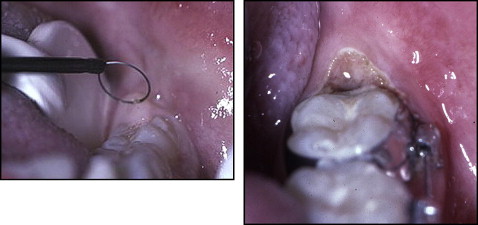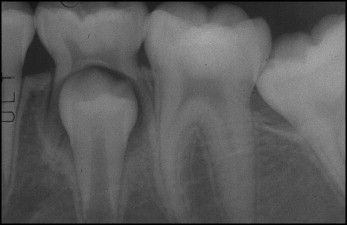Second molars can create great delays in orthodontic treatment if they are not managed intelligently. The purpose of this article was to describe common torque and position problems of the second molars and techniques for managing them. A simple technique for freeing mesially impacted second molars is presented.
Aligning second molars is a challenge for a clinical orthodontist. When these teeth erupt, they are often tipped, with the mandibular second molars tipped lingually and the maxillary second molars tipped buccally. Even if the crowns move into their correct positions in the normal arch form, the roots are often misplaced, producing excessive palatal root torque in the maxillary arch (with low-hanging lingual cusps) and excessive buccal root torque in the mandible (depressed lingual cusps). To add insult to injury, the mandibular second molars are often impacted; this can be a consequence of aggressive arch-length conservation in the mixed or transitional dentition.
After preliminary leveling, the maxillary second molars often have extruded lingual cusps requiring intrusion and buccal root torque. The mandibular second molars are often depressed in relation to the first molars and need lingual root torque.
The second molars often erupt late during treatment, tempting the practitioner to ignore them altogether. The purpose of this article is to present methods to prevent, minimize, or correct the problems listed above.
Timing of treatment
Comprehensive treatment or phase 2 treatment should not be started until the mandibular second molars can be correctly banded (or bonded). Waiting for these molars before starting treatment will definitely shorten treatment time and better maintain patient cooperation, which wanes drastically when treatment drags on. The maxillary second molars usually erupt a bit later and can be banded at the quality-control reset appointment. This will avoid the later time-consuming step of banding and releveling the second molars after the other teeth have been leveled. This is especially true if a second molar is impacted. Impactions can be dealt with easily with a minimal appliance before full fixed appliances. All remaining teeth can stay unbanded while the impacted molar is freed and allowed to erupt. If a distal operculum is preventing banding, it can be easily removed with an electro-surgery procedure by using local infiltration anesthesia ( Fig 1 ).

Impacted mandibular second molars
Most impacted mandibular second molars are tipped mesially and need to be tipped distally so that they can clear the mandibular first molar ( Fig 2 ).

Sometimes, the second molar’s distal movement is blocked by a mesially displaced third molar. If the third molar is impacted or incapable of ever erupting into a useful position, consider having it extracted when the oral surgeon exposes the occlusal aspect of the second molar. Oral surgeons do not like taking out third molars in 12- to 13-year-olds, but they are specialists, and this is a necessary part of their field. Please emphasize that only the occlusal aspect of the second molar needs to be freed of tissue. The attachment should be bonded just to the occlusal surface of the tipped second molar.
Impacted mandibular second molars
Most impacted mandibular second molars are tipped mesially and need to be tipped distally so that they can clear the mandibular first molar ( Fig 2 ).
Sometimes, the second molar’s distal movement is blocked by a mesially displaced third molar. If the third molar is impacted or incapable of ever erupting into a useful position, consider having it extracted when the oral surgeon exposes the occlusal aspect of the second molar. Oral surgeons do not like taking out third molars in 12- to 13-year-olds, but they are specialists, and this is a necessary part of their field. Please emphasize that only the occlusal aspect of the second molar needs to be freed of tissue. The attachment should be bonded just to the occlusal surface of the tipped second molar.
Technique
- 1.
Surgically expose just the occlusal surface; extract the third molar at the same time, if indicated.
- 2.
Fabricate a custom eyelet and bond it in the second molar’s central groove with the vertical loop portion touching the distal portion of the first molar ( Fig 3 , A ).
Fig 3 A, Fabrication of the 0.014-in custom eyelet. The eyelet is bent perpendicular to the twisted pigtail, which is bonded in the central groove with the eyelet touching the first molar. B, Exploded view of the distal tipping assembly. C, The 100-g superelastic spring is held fully compressed as the 0.018-in wire is placed through the first molar tube from the distal aspect. D, A second needle holder locks on the wire so that the spring will remain compressed after the distal needle holder is released. With the needle holder locked mesially, use the prethreaded ligature wire to tie the looped end of the 0.018-in wire to the custom eyelet.
Stay updated, free dental videos. Join our Telegram channel

VIDEdental - Online dental courses


